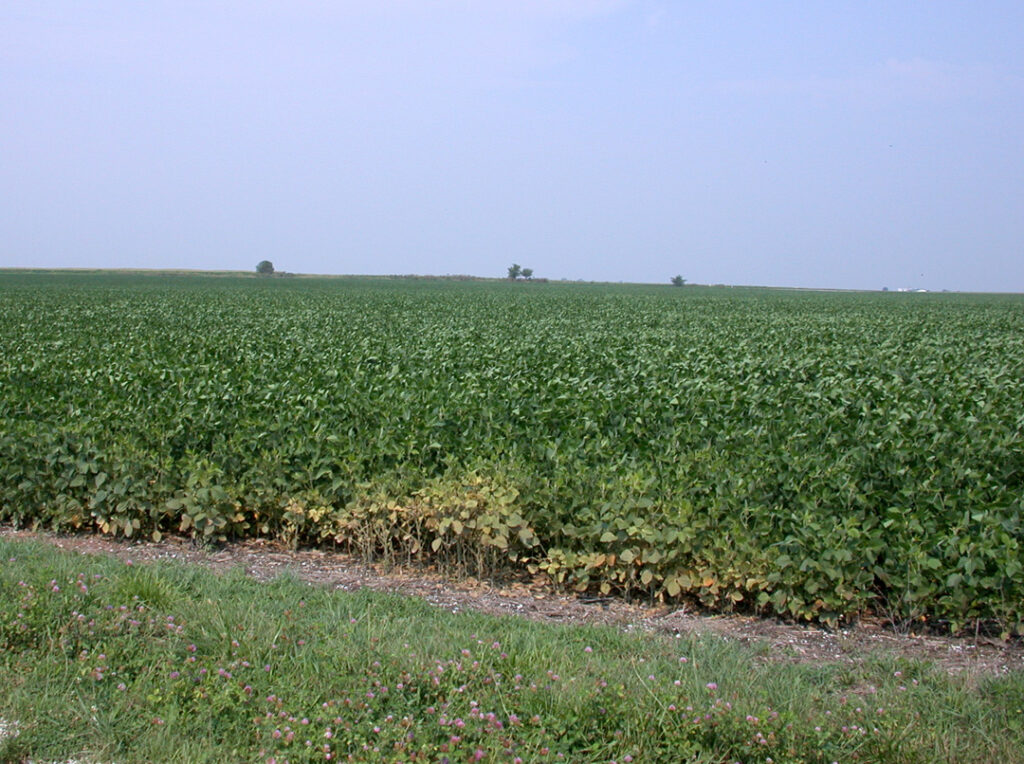Some areas of Indiana remain very dry and concerns of spider mites moving into fields from parched field/road sides increase. The symptoms will almost always be noted first at field edges. Discerning the subtle yellowing of the foliage in stressed areas should be followed up with immediate scouting. Of course, many other factors can cause plants to yellow (nutrient deficiencies, soybean cyst nematode, disease, lack of moisture, compaction, herbicide damage, etc.), so you should confirm that mites are present. Delayed scouting, once plants are bronzed in color, gives spider mites time to colonize further into/throughout the field. Spider mite damage to plants is irreversible, even with ample rainfall – these leaves won’t “green up” again.
If the problem is due to spider mites, a good understanding of the pest’s biology, level of infestation, potential for damage, and management alternatives are needed to properly deal with the infestation. Along field edges of moisture stressed soybean, scout for spider mites and look for feeding damage. Shake discolored plants over a white piece of paper and watch for small, dark specks (1/60 inch in length) moving about. Do not confuse these with the lighter colored, elongated thrips which are at least twice as long. Often the edges of the field will be most heavily infested, as mites move from grasses and various broadleaf weeds (including clover) onto soybeans. Sample at least 5 different areas of the field and determine whether the spider mites are present or not by using the “shake” method.
It is important to understand the impact of weather upon spider mites already in fields:
Extended hot and dry conditions will:
- encourage the movement of spider mites from drying field edges to soybean
- favor rapid (explosive!) reproduction of spider mites
- cause spider mites to increase their feeding
- dramatically reduce fungal pathogens that normally keeping spider mites in check
- create moisture stressed plants that provides a higher concentration of nutritious fluids (“protein broth”)
The best “cure” for spider mite issues is moisture. A significant rainfall (1 inch or more) followed by high humidity will:
- physically kill some spider mites by dislodging them from the plant
- encourage the growth, development, and dissemination of beneficial fungal pathogens
- recharge the plant’s fluids, making them less to conducive to spider mites
For soybean fields scheduled for a fungicide application, should an insecticide, i.e. synthetic pyrethroid, be added to pick up the annoying Japanese beetles, grasshoppers, and various other foliage feeders? There is no reason to think it will be anything but a waste of time and money, and could actually cause problems.
Lurking in every soybean field are low numbers of spider mites. We rarely notice them when conditions remain “normal”, as they are being fed upon by a range of predatory insects and spiders. However, treating fields with insecticide may tip the balance in the favor of potential pests. This is because natural enemies recover more slowly from broad-spectrum insecticides compared with mites and aphids, which have an extremely rapid generation time and are generally more difficult to kill with insecticides.
Dry conditions exacerbate crop damage from mites. One major reason for this is that fungal pathogens, that cause insect/mite diseases, do not flourish. Just as crop diseases (most of which are moisture-loving fungi) are more likely during wet/high humid conditions, so are insect diseases. An epizootic is quite impressive, as potentially damaging populations of billions of mites/aphids are quickly and thoroughly wiped out. Fungicides sprayed for crop diseases also suppress insect pathogens. This is one reason why high-value crops, e.g., fruits and vegetables, receiving prophylactic (calendar sprays) of fungicide and insecticide often have spider mite flare-ups.
This short video demonstrates spider mite sampling to confirm their presence.




